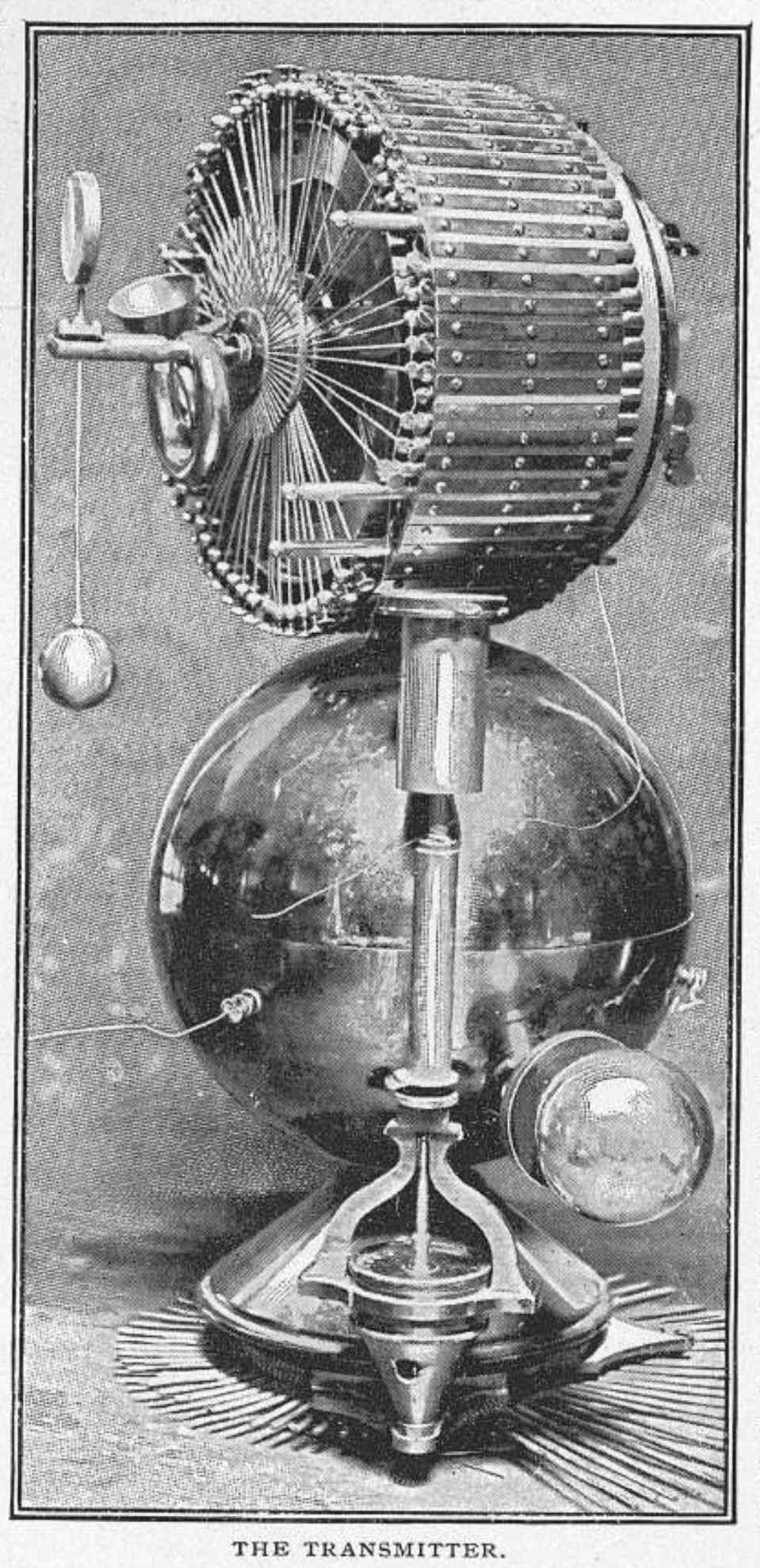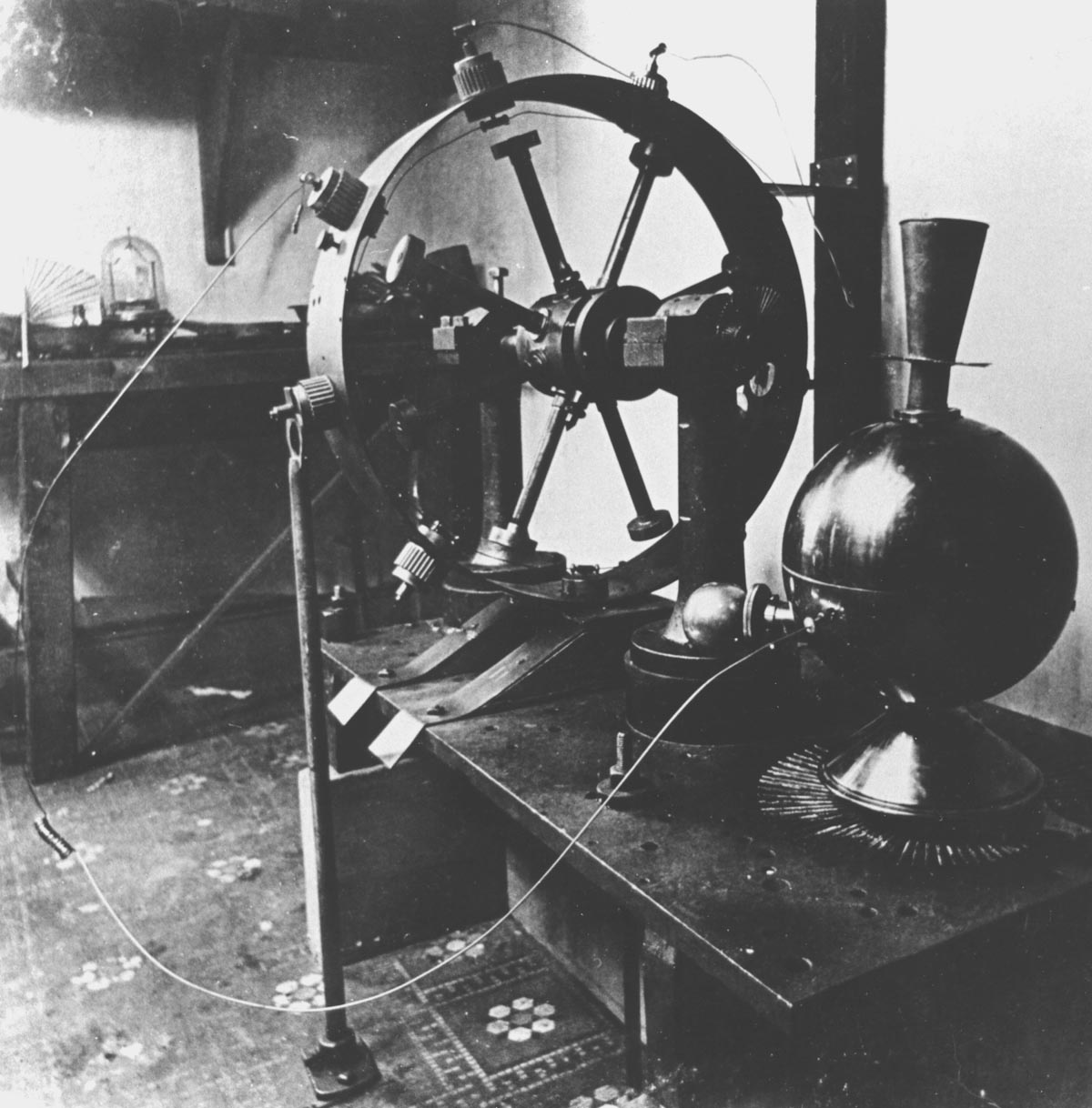
Keely invented and used diverse types of "transmitters".
Keely
"The experiment illustrating "chord of mass" sympathy was repeated, using a glass chamber, 40 inches in height, filled with water, standing on a slab of glass. Three metal spheres, weighing about 6 ounces each, rested on the glass floor. The chord of mass of these spheres was B flat first octave, E flat second octave and B flat third octave. Upon sounding the note B flat on the sympathetic transmitter, the sphere having that chord of mass rose slowly to the top of the chamber, the positive end of the wire having been attached, which connected the covered jar with the transmitter. The same result followed the sound of the other spheres, all of which descended as gently as they rose, upon changing the positive to the negative. J.M. Wilcox, who was present remarked: "This experiment proves the truth of a fundamental law in scholastic philosophy, that when one body attracts or seeks another body, it is not that the effect is the sum of the effects produced by parts of one body upon parts of another, one aggregate of effects, but the result of the operation of one whole upon another whole." [Snell Manuscript - The Book, page 3]
In all molecular dissociation or disintegration of both simple and compound elements, whether gaseous or solid, a stream of vibratory antagonistic thirds, sixths, or ninths, on their chord mass will compel progressive subdivisions. In the disintegration of water the instrument is set on thirds, sixths, and ninths, to get the best effects. These triple conditions are focalized on the neutral center of said instrument so as to induce perfect harmony or concordance to the chord note of the mass chord of the instruments full combination, after which the diatonic and the enharmonic scale located at the top of the instrument, or ring, is thoroughly harmonized with the scale of ninths which is placed at the base of the vibratory transmitter with the telephone head. The next step is to disturb the harmony on the concentrative thirds, between the transmitter and the disintegrator. This is done by rotating the siren so as to induce a sympathetic communication along the nodal transmitter, or wire, that associates the two instruments. When the note of the siren becomes concordant to the neutral center of the disintegrator, the highest order of sympathetic communication is established. It is now necessary to operate the transferable vibratory negatizer or negative accelerator, which is seated in the center of the diatonic and enharmonic ring, at the top of the disintegrator, and complete disintegration will follow (from the antagonisms induced on the concordants by said adjunct) in triple progression, thus: First thirds: Molecular dissociation resolving the water into a gaseous compound of hydrogen and oxygen. Second: sixths, resolving the hydrogen and oxygen into a new element by second order of dissociation, producing what I call low atomic ether. Third: ninths, the low atomic ether resolved into a new element, which I denominate high or second atomic harmonic. All these transmissions being simultaneous on the disturbance of sympathetic equilibrium by said negative accelerator. [Snell Manuscript - The Book, page 4]
"The circles containing the sensitized disks - both polar and depolar - are in sympathetic relation to the polar negative circuits of the earth, and in a condition to be brought into action by the negative transmitter. The sympathetic conditions of the polar and depolar field of the circuits remain latent until the transmitter is associated and the introductory impulse given. Then conditions assert themselves which demonstrate the wonderful power of sympathetic action in abeyance to the laws by which they are governed." [The Operation of the Vibratory Circuit]
"The polar flow, as induced by the transmitter, is intensified or diminished by an oscillating bar which governs the revolutions to any number without variation." [The Operation of the Vibratory Circuit]
"In the Center is placed a resonating intensifier, through which the sympathetic currents pass. By a spiro-vibrophonic arrangement these currents are diverted toward the neutral center of the earth. This device is the sympathetic multiplying agent for the polar field, and the negatizing agent for the anti-polar field. When under action it is entirely subservient to the transmitter, both in regard to high intensification and thorough neutralization of polar and depolar interchange." [see Rhythmic Balanced Exchange], [The Operation of the Vibratory Circuit]
"The series of experiments, daily for one week, that I am now preparing to give before an expert committee, for the purpose of enabling this committee to make a public announcement of the scientific and commercial value of my system of sympathetic vibratory physics, comprises:
First. - Operation of the polar circuit, drawing power from space, and showing control of various degrees of velocity.
Second. - Sensitization of a polar disk, after having had its complete neutrality to magnetism tested.
Third. - After associating it with the polar test-medium, heavily weighting it to demonstrate its attractive power; the weight remaining suspended to it by this power.(7)
Fourth. - Transmitter connected to the test-medium, while the disk is carrying the weight. Negative vibration transferred; effecting complete dissociation; the disk and weights dropping to the floor.
Fifth. - Rotation of compass needle, on a set of resonators, subservient to any one of the resonators, in defiance of its attraction to the north. Variations given; changing its subservience to different resonators, as the introductory impulse is changed.(8)
Sixth. - Mediums, representing the chords of different masses of metal, made to float in a tall jar of water, with extraordinary changes of position.
Seventh. - Operations of a sensitized globe, by sound.
Eighth. - Operations of the globe under the influence of the improved polar sympathetic transmitter.
Ninth. - Disintegration of water by triple vibration,(9) showing progressive degrees of energy (from molecular to interatomic, etc., etc.) on different rates of transfer." [The Operation of the Vibratory Circuit]

"All vibrations that are negative in their character as toward destroying the harmonic relations that exist between the magnetic current and its coincident polar, to carry out the simile, close up the aperture whereby illumination (or transfer) is continuously conducted.
The thirds, on the subdivision of the one hundred and twenty-eight thousand four hundred vibrations, represent the negative antagonism, whereby this peculiar condition is brought about, viz., forty-two thousand eight hundred on the positive; the same on the negative and on the neutral, as associated with the sympathetic negative transmitter.
The keeper is first placed on the magnet, which has an attachment whereby a transmitter can be centrally associated with it; the other terminal having three connections that can be attached to this medium. The impulse is given simultaneously to the three leads after setting the instrument to represent forty-two thousand eight hundred vibrations on the harmonic, the same on the enharmonic and on the diatonic.
If this impulse is given properly, the neutralization will take place within fifteen seconds." [The Operation of the Vibratory Circuit]
Schauberger
The outcome of this incessant reciprocal activity on the one hand is the reconstitution of the various kinds of water present in the individual zones, and on the other, the constant transformation of the species of vegetation in which water makes its way, ceaselessly moved by this inner interplay of forces. This inner, energetic interaction, however, is opposed by the effect of the water's weight. The alternating magnitudes of these component forces inevitably lead to the constant rising and falling of the water particles - the so-called pulsation of water. Every new formation and all growth is derived from the smallest beginnings. Continuing development in the early stages can only be accomplished if the circulation in the Earth's interior proceeds correctly. According to inner law, every higher form of vegetation is built up from the lower species preceding it. The carrier of the substances and the transmitter of the life-processes in the root-zone is the groundwater. The impulse for its movement is caused by a drop in temperature, to which the inner metabolic processes of the here decisive groups of basic elements give rise. The impulse for the movement of water is thus a product of the interactions between the opposites contained within it, which find their necessary resistance in the water itself. Through the resistance arising from the interactions between carbone and oxygen, fluctuations in temperature again occur and with them the impulse to move - the pulsation of water, which in this way at times dissolves salts and at others deposits them, transports them, creates energies and transforms them. The sense and purpose of these perpetual transformation processes is the creation and maintenance of the various types of vegetation and physical forms, which on their part again represent the bridges for the build-up and maintenance of the energies. [The Energy Evolution - Harnessing Free Energy from Nature, Conclusions]
By means of mechanical diffusion this transmitter generates a horizontal potential field and rapidly cools the gas mixture. Having become highly [The Energy Evolution - Harnessing Free Energy from Nature, Letter to Werner Zimmermann]
See Also
bequeathal
carrier
Figure 19.09 - The Vibrodyne and Sympathetic Transmitter
giving and regiving
Keelys Mechanical Inventions and Instruments
nodal transmitter
Sympathetic Negative Transmitter
Sympathetic Transmitter
Three-node transmitter
vibratory transmitter
